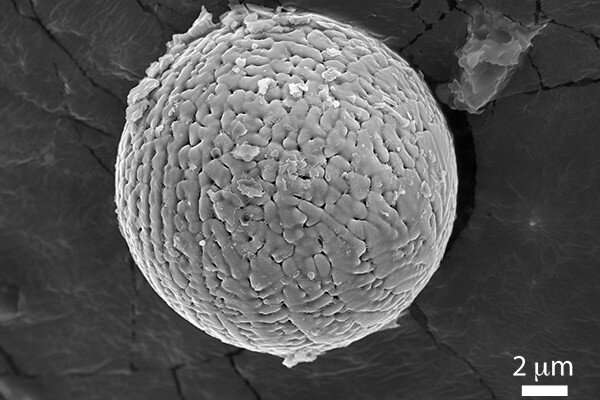Meteorites reveal high carbon dioxide levels on early Earth

Tiny meteorites no larger than grains of sand hold new clues about the atmosphere on ancient Earth, according to scientists.
Iron micrometeorites found in ancient soils suggest carbon dioxide made up 25 to 50 percent of Earth's atmosphere 2.7 billion years ago, and that pressure at sea level may have been lower than today, Penn State researchers said.
The meteorites melted as they streaked through the atmosphere and oxidized as they encountered atmospheric gases. Evidence of the oxidation remains on the tiny fragments that landed on Earth. The samples serve as a unique proxy for conditions in the upper atmosphere, the scientists said.
"This is a promising new tool for figuring out the composition of the upper atmosphere billions of years in the past," said Rebecca Payne, a doctoral candidate in geosciences and astrobiology at Penn State. Payne is lead author of the study, published recently in the journal Proceedings of the National Academy of Sciences.
The work builds on previous studies of the micrometeorites that suggested free oxygen molecules in the upper atmosphere oxidized the meteorites. Those findings would require oxygen levels on ancient Earth to be near modern day levels, a surprising conclusion that contradicts conditions expected on the young planet, Payne said.
The researchers conducted a new analysis using photochemical and climate models and determined carbon dioxide, not oxygen, likely served as the main oxidant. For this to be possible, they found carbon dioxide had to comprise at least 25 percent of the atmosphere.
Those levels of carbon dioxide would suggest a warm planet, but other climate evidence finds Earth was cool at the time and partly covered by glaciers. Lower nitrogen levels resulting in lower pressure would allow for both high carbon dioxide levels and cool conditions.
"There are data, referenced in our paper, that support lower nitrogen concentrations during this time," said Jim Kasting, Evan Pugh University Professor in the Department of Geosciences at Penn State and Payne's adviser. "Our study of micrometeorite oxidation falls in line with that interpretation. The possibility that our major atmospheric gas, nitrogen, was less abundant in the distant past is really intriguing."
The findings may help reconcile disagreements in previous studies on carbon dioxide in the deep past and climate model estimates, according to the researchers.
Previous estimates of carbon dioxide levels from billions of years ago rely on paleosols, or ancient soils, which may better reflect conditions in the lower atmosphere. Regional differences like weather or ground cover also can impact paleosols samples, and the findings from these studies often contradict each other and climate models, the scientists said.
"It was getting difficult to figure out where the agreement should have been between different paleosol studies and climate models," Payne said. "This is interesting, because it's a new point of comparison. It may help us find the right answer about atmospheric carbon dioxide in the deep past."
More information: Rebecca C. Payne et al, Oxidized micrometeorites suggest either high pCO2 or low pN2 during the Neoarchean, Proceedings of the National Academy of Sciences (2020). DOI: 10.1073/pnas.1910698117
Journal information: Proceedings of the National Academy of Sciences
Provided by Pennsylvania State University





















